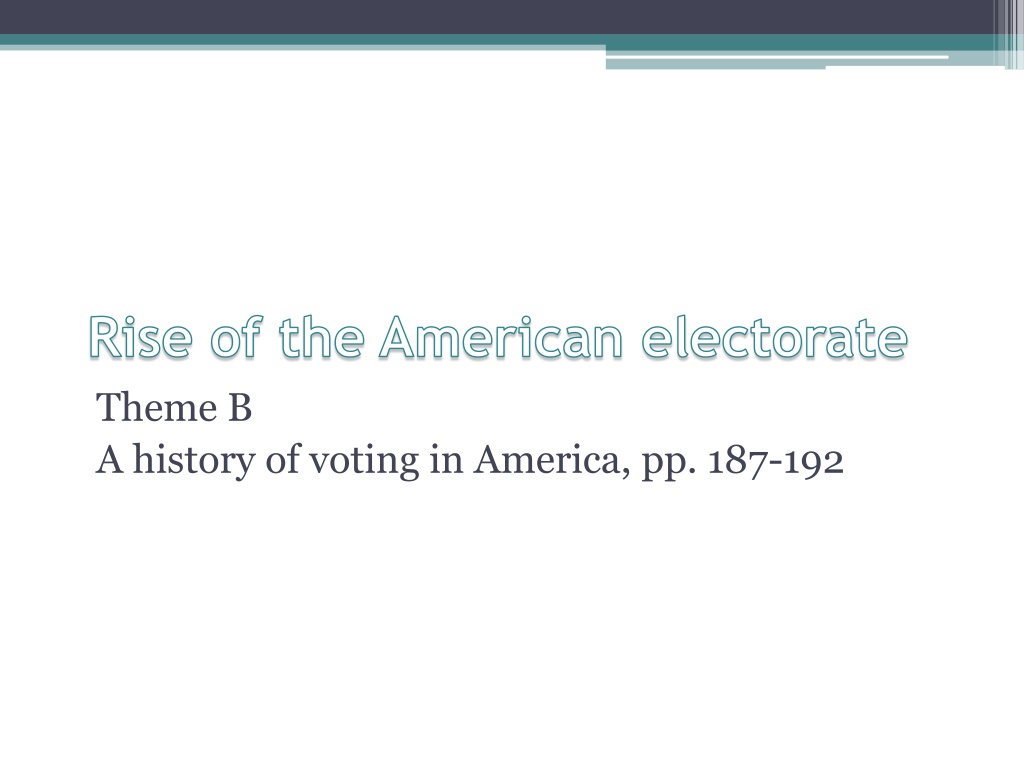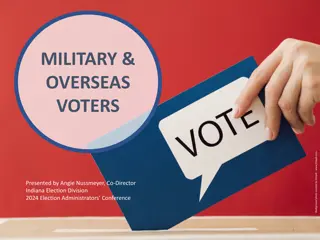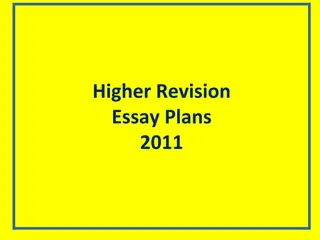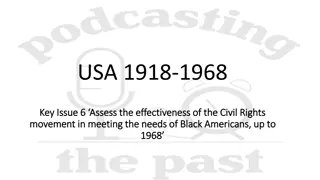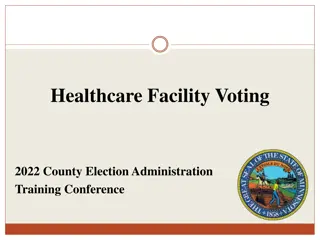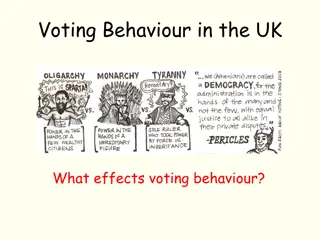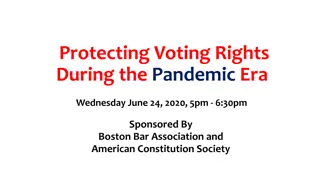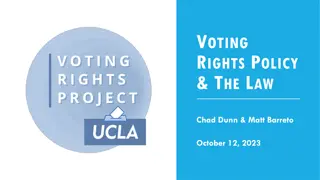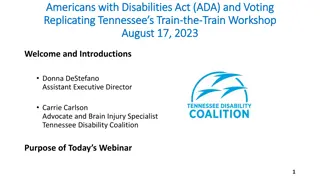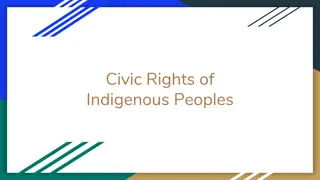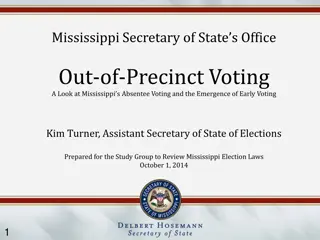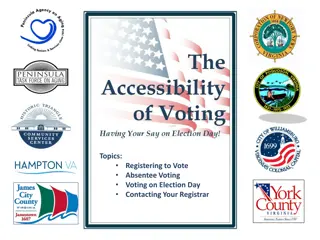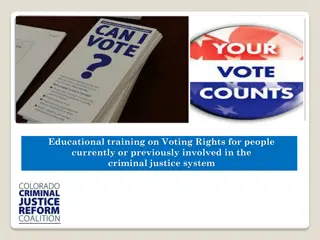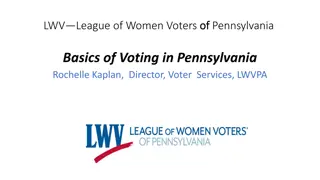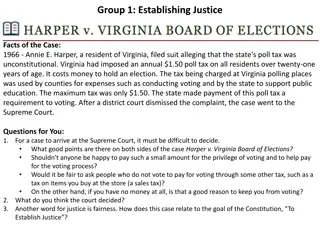Evolution of Voting Rights in America
The evolution of voting rights in America is a complex journey marked by milestones such as voting amendments, historical perspectives, changes in voting methodology, and significant events like the 15th Amendment, women's suffrage, and the 26th Amendment. This progression reflects a gradual expansion of the electorate and increased inclusivity over time.
Download Presentation

Please find below an Image/Link to download the presentation.
The content on the website is provided AS IS for your information and personal use only. It may not be sold, licensed, or shared on other websites without obtaining consent from the author.If you encounter any issues during the download, it is possible that the publisher has removed the file from their server.
You are allowed to download the files provided on this website for personal or commercial use, subject to the condition that they are used lawfully. All files are the property of their respective owners.
The content on the website is provided AS IS for your information and personal use only. It may not be sold, licensed, or shared on other websites without obtaining consent from the author.
E N D
Presentation Transcript
Rise of the American electorate Theme B A history of voting in America, pp. 187-192
Voting Amendments 1. 15thamendment 2.17thamendment 3.19thamendment 4.23rdamendment 5.24thamendment 6.26thamendment
Historical Perspective of the American Electorate For the 1st50 years of the US only white/male/property owners could vote-By 1880, only 14% of adults could vote. African-Americans could not vote for the first 176 years of US History Women did not have the right to vote for the first 131 years of US It took 181 years for those 18-20 to get the right to vote
Voting Methodology The Constitution left voting to be determined by the states. Only members of the HOR were originally elected at the national level. States set the when, how, and by whom aspects of the elections. These varied widely. With amendments, litigation & legislation, the electorate slowly expanded.
Milestones A. Jackson s easing of property restrictions in the 1830s Issue of Federalism? States initially set voter restrictions & qualifications, but the federal gov t gradually took over through the 14th & 15thAmendments to the present where it has almost total control
Milestones 15thAmendment- right to vote not denied on account of race The Supreme Court in 1870s decided that Amendment did not confer the right to vote; merely the denial could not be explicitly on ground of race Problem...states set up literacy tests, poll taxes, white primaries, and grandfather clauses Solution 1965 Voting Rights Act & 24thAm. Impact: Black voters increased and began to affect political outcomes in the South.
Alabama Literacy Test http://kpearson.project.tcnj.edu/interactive/im m_files/test.html As a group, answer the questions. All responses must be correct or NONE of you can vote!
Milestones States started to allow women to vote in 1915 (ex. Wyoming) eventually leading to 19thAmendment in 1920 18 year-olds got the right to vote in 1971 as the 26thAmendment was ratified. Largely due to the Vietnam Conflict. Average age of the drafted war dead was 19. What impact did these 2 groups have on elections?
Effects of increased eligibility Were unforeseen- newly eligible voters did not flock to one particular party over another and did not vote for radical candidates or issues So why the continuing low-voter turnout?
Explaining Voter Turnout Decline in popular interest in elections Weakening of competitiveness between political parties Decline more apparent than real: Voters were more easily manipulated in past Voter fraud prevalent (Public polling, Party ballots, floaters voted early and voted often and parties counted and the padded ballots) before Australian Ballots adopted around the turn of century.
Explaining Voter Turnout Political withdrawal- fewer citizens felt close enough to or care about government to be interested in voting Rational ignorance effect- when people purposely decide not to become informed on an issue because they believe that their vote on the issue is not likely to be a deciding one; a lack of incentive to seek the necessary information to cast an intelligent vote
Explaining Voter Turnout Unintended consequences of stricter voter restrictions Registration process reduced voting Requirements of the Progressives in the early 1900s caused a drop in voter turnout in an effort to prevent fraud Disenfranchised legal voters, too.
Help America Vote Act of 2002 (HAVA) Passed as a result of the 2000 election mess and Bush v. Gore decision. Requires every state to have a method of counting disputed ballots and voters. NC created provisional ballots-Everyone can vote, but local Board of Elections determine which count. Set aside money for states to update equipment.
How to improve US turnout rates: Using your notes, defend or attack the following: Compulsory voting Make voting on issues less complicated and less frequent Institute proportional voting rather than winner-take-all Strengthen the two-party system Vote on the weekends Turn election day into a holiday
Assignment Read the rest of chapter 8. Take notes on the type of voters. Use how do we vote? sheet to label each from reading. Read Guarding against voter fraud handout. Answer questions at the end. Due Tuesday of next week.
